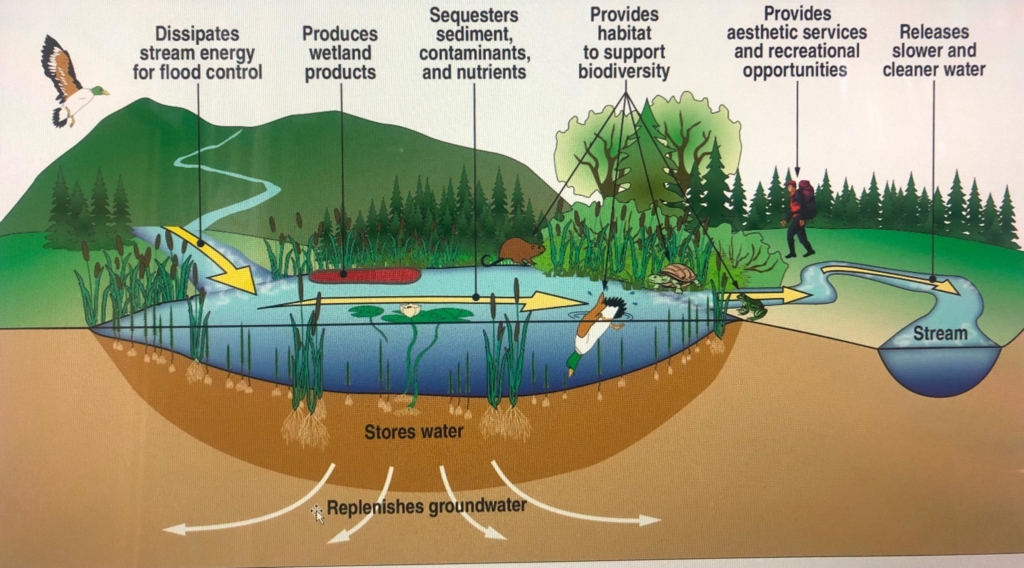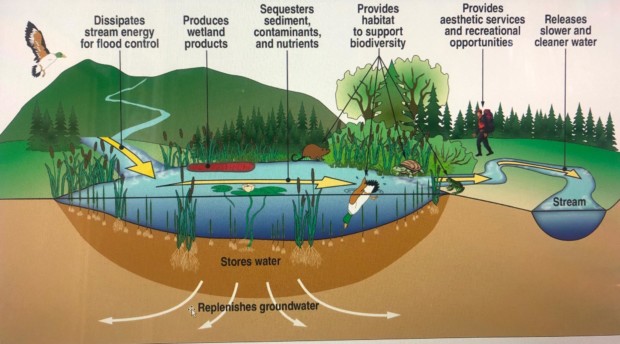Water Purification as Defined by Nature
By Amelia Rozelle
Wetlands are valuable ecosystems which naturally purify water. By this action and a lot of different benefits, they are considered to be indispensable.Lha is taking action and publishing articles about water, and this prompts the question:why not copy what nature is doing toimprove our water quality?According to the international treaty of Ramsar, wetlands are defined as “areas of marsh, fen peat land or water, whether natural or artificial, permanent or temporary, with water that is static or flowing, fresh, brackish or salt, including areas of marine water the depth of which at low tide does not exceed six meters” (Article 1.1 of Ramsar convention). This treaty, signed in 1971 in Iran by 169 countries, was created to bring about national action and international cooperation for the conservation and wise use of wetlands and their resources.Wetlands are indispensable for the countless benefits or “ecosystem services” that they provide (Fig. 1). These range from freshwater supply, food and building materials and sites for biodiversity, to flood control, groundwater recharge and climate change mitigation (ramsar.org). They also provide significant economic, social and cultural benefits (primary products, tourism, science…).Some wetland sites are designated as being of international importance under the Ramsar Convention with different criteria (Ramsar sites criteria). Figure 1: some ecosystem services provided by wetlands (www.exponent.com)
Figure 1: some ecosystem services provided by wetlands (www.exponent.com)
To create awareness of their importance, there is also a World Wetlands Day on 2 February every year. In 2018, the theme was “Wetlands for a sustainable urban future”.
The Ramsar Convention was signed in India on 1 February 1982. India currently has 26 sites designated as Wetlands of International Importance (Ramsar Sites), with a surface area of 689,131 hectares.With its varying topography and climates, India supports diverse and unique wetland habitats distributed in different geographical regions ranging from the Himalayas to the Deccan plateau. In Tibet, the Autonomous Region has high-altitude marshes and lakes with important hydro logical functions which are extremely valuable sites for migratory birds, including the endangered Black-necked Crane:Grus nigricollis (Ramsar.org).
Despite their importance, wetlands face many threats including invasive species, drainage, degradation or destruction. Their area and quality continue to decline in most regions of the world which,as a result, decreases the ecosystem services they provide(environment.nsw.gov.au).In India, the main causes of water pollution are due to the runoff of agricultural pesticides and fertilizers, and industrial wastewater which causes eutrophication. When sediments overwhelm, the environment becomes eutrophicated which means too much organic matter, increasing the utilization of oxygen by bacteria and algae which in turn depletes the water’s oxygen and leads to dead zones. Alternatively, some pollutants enter the food chain and can be lethal to predators (fish, birds, humans,etc).
How to manage the water pollution?
A lot of innovations are inspired by nature: for example, burrs inspired the invention of Velcro, jets were inspired by birds, turbines by whales andbuildingsfollowedtheexample of termites.
In this field, ecological engineering has developed increasingly over recent years: it is defined as “the design of sustainable ecosystems that integrate human society with its natural environment for the benefit of both” (Mitsch, 2012).
Regarding natural wetlands, the larger aquatic plants growing there, usually called macrophytes, have a high microbial activity which involves a high capacity to decompose organic matter and other substances (Moshiri, 1993). By mimicking the natural process of wetlands,a wastewater treatment system is defined as one in which aquatic macrophytes have a key function.
More generally, phyto-purification is an individual sanitation system for wastewater working with plants.This technique has many advantages, especially ecologically, as it reduces the pollution of surface water and groundwater without requiring energy.The phyto-purification system is reliable and efficient. Moreover, it integrates perfectly with the landscape, without giving off a bad smell.
How it works?
Phyto-purification uses the bacteria naturally present in the root system of plants to purify the water. Then they transform this organic matter into mineral matter assimilable by plants. In return, aquatic plants provide oxygen to the bacteria through their roots (uniassignment.com).
Thus, phyto-purification systems are using selected plants species that are able to absorb pollutants such as nitrates or phosphates.
Typha, Phragmites, Eichhornia, Azolla, and Lemna are some of the identified potent wetland plants for heavy metal removal (Bassiet al., 2014).
These planted filters reproduce a natural purification ecosystem in several stages (Fig. 2):
- Pre-treatment via gravel (stones) and aquatic plant roots that retain large particles on the surface. These elements will turn into compost.
- Treatment of chemical compounds through several basins filled with substrate and plants; the plants absorb the nitrates and phosphates contained in the urine and feces. Natural chemical treatment also allows the decomposition of household pollutants.
- Biological treatment, with bacteria breaking down accumulated deposits in the roots to transform them into nutrients for plants.
 Figure 2: example of water treatment system (www.butane.chem.uiuc.edu)
Figure 2: example of water treatment system (www.butane.chem.uiuc.edu)
This technique has some technical inconveniences. The depth of the plant roots is important to considerin regard to the available space to make an optimal clean-up. Concerning the monsoon, the excess of water must be taken into account.
As Mitsch said (2012), human society, as “part of” nature and not “apart from” nature, would do well to recognize and use the important functions of nature (rather than destroy them) to provide a resilient and sustainable society.



[…] https://tibetnature.net/en/water-purification-as-defined-by-nature […]